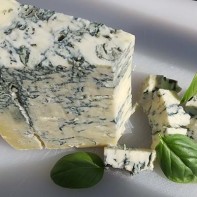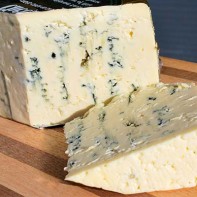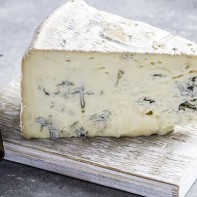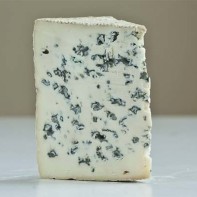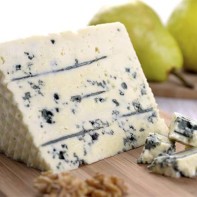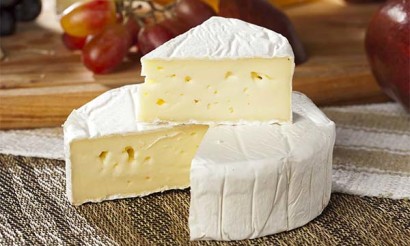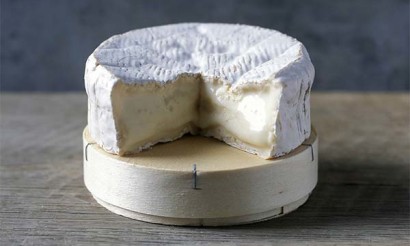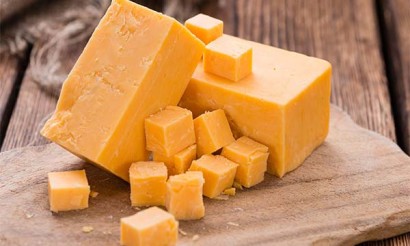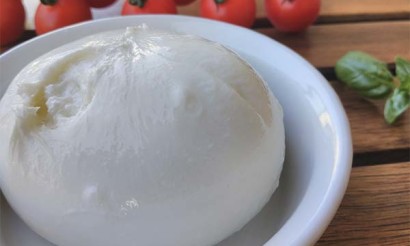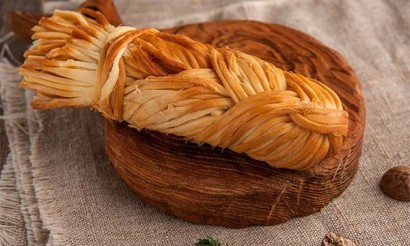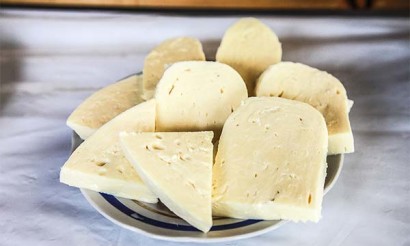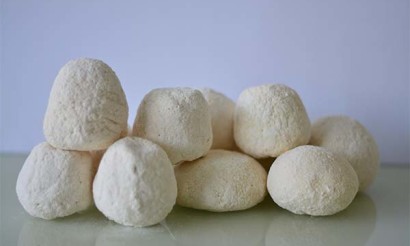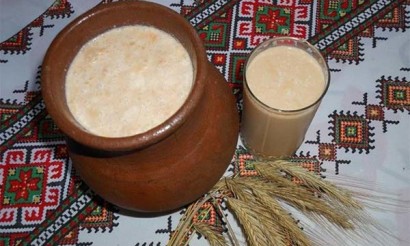Gorgonzola: what it is, what it tastes like, what is useful, how to cook it
Gorgonzola is a variety of Italian cheese that has a mottled, patterned structure. The product is considered a delicacy. It has a slightly spicy taste, which classifies it as a kind of blue cheese. The cheese received this name because of a mold culture of a bluish-greenish hue that sprouted in the cheese mass.
- Gorgonzola: what kind of cheese is it?
- History of origin
- Production technology
- Types
- What does gorgonzola smell like?
- How gorgonzola differs from dor-blue and Roquefort
- From Dor Blue
- From Roquefort
- Composition and Calories
- What is gorgonzola cheese good for?
- Hazards and contraindications
- How to choose and store it correctly
- How and with what you eat gorgonzola
- What wine to match gorgonzola
- Where to buy and how much costs
- How to cook gorgonzola at home
- Recipes for Gorgonzola dishes
- Pizza with Pear
- Mussels
- Pasta with Cheese
- Cheese Soup
- Ice Cream
- What can be substituted for gorgonzola cheese in a recipe
- Interesting facts about cheese
Gorgonzola: what kind of cheese is it?
History of Origin
It is known that this cheese product originally appeared at the end of the ninth century near the gates of Milan. The first name was Stracchino. It was made from cow's milk. The word stracca means "tired" in Italian. The inhabitants, leading the cows from the pasture to rest, used to call them "tired". Cow's milk was excellent for making soft kinds of cheese.
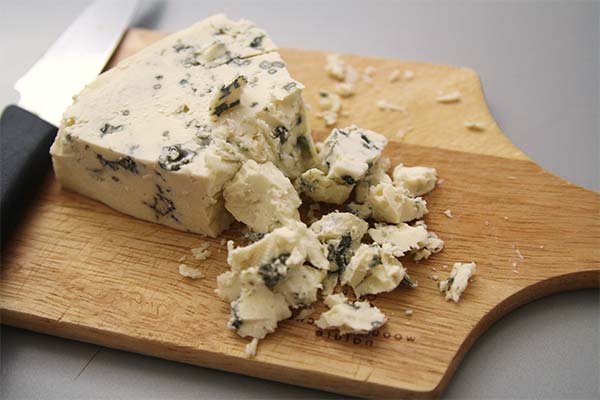
According to the second version, it was thought that the variety originated in the city of Valsassina, which was famous at the time for its cheese-making.
But there is a legend that eclipses both opinions on the appearance of the cheese. It tells how a young young man, in love with the girl of his dreams, stopped making cheese in the evening and went on a date. And in the morning, to correct his mistake, he mixed the leftover curd mass from the evening with fresh milk. So, after a while, there were streaks of blue color in the cheese. But the taste of the product was simply magnificent and conquered even the most talented gourmets.
There is another legend, when a cunning and dishonest peasant, who decided to get rich on merchants passing by the village. Making cheese, he offered them some of his product, which had long been stale and covered with mold. The cheesemaker hoped that the merchants, who came from far away, would not return the bad goods. But he was mistaken, because a couple of weeks later, they came back, only this time with a request to sell another batch of the same product. Since then, the recipe for making gorgonzola has been passed down through generations.
But, as it turns out, there is another version of how gorgonzola cheese came into being. And it happened in the northern part of Italy, Lombardy. A master was fed up with his drunken guests. He decided to serve them with a stracchino cheese to make them leave his house as soon as possible. But this idea failed, because the guests liked the product - it went perfectly with the wine served earlier.
A little later the production of Gorgonzola began to increase noticeably, occupying a larger territory. And it was Novara, famous for its advantageous geographical position, natural wealth of water, plenty of pastures and an increase in cattle, that became the new capital of Gorgonzola. Hence the name of the cheese.
Production technology
For several centuries in a row the recipe for making gorgonzola cheese has changed several times, something new and improved was added. The most important ingredient is cow's milk with a small proportion of goat's milk. The evening and morning milk is collected, mixed with cream and pasteurized. The mass is then piled into a cylindrical container, with a natural cloth overlaying the bottom. To drain the whey faster, cheese heads are turned from time to time. After two weeks, they are removed from the dish and rubbed with salt. Make a special long needle puncture, where the mold spores are inserted. To accelerate the growth of mold fungi, the cheese mass is pierced with several metal tubes, through which oxygen enters unhindered. As a result, the finished product shows parallel emerald green stripes.
Types of
There are only two types of gorgonzola cheese in Italy:
- Gorgonzola Dolce or Gremificato is a young variety of cheese that has the consistency of paste, with blue streaks of mold. It is cooked for two months. Taste of this variety is sweet, with delicate hints of nut. It is of mild texture.
- Gorgonzola Piccante. This type of cheese takes about four months to mature. Stronger in texture, with more moldy streaks. It has a spicy rich flavor.
The main flavor quality of gorgonzola is a sweet and creamy flavor, with a characteristic sharpness coming from the mold. This bouquet creates a starchy feeling in the mouth. Hints of a mild mushroom flavor are present.
What does gorgonzola smell like
The main smell of this type of cheese is acid, similar to sour cream cheese. But the aroma is significantly different from its taste. One type of gorgonzola, namely Gorgonzola Piccante formaggi CIRTSA, reeks of raw germinated mold and mushroom basement dampness. A little taste of sunflower seeds, its lightly toasted husk, and a barely perceptible note of melted milk flavor come through.
How gorgonzola differs from dor-blue and Roquefort
When making different kinds of cheese, cheesemakers always rely on each product being different from the other. For example, gorgonzola, Roquefort, and dor-blue.
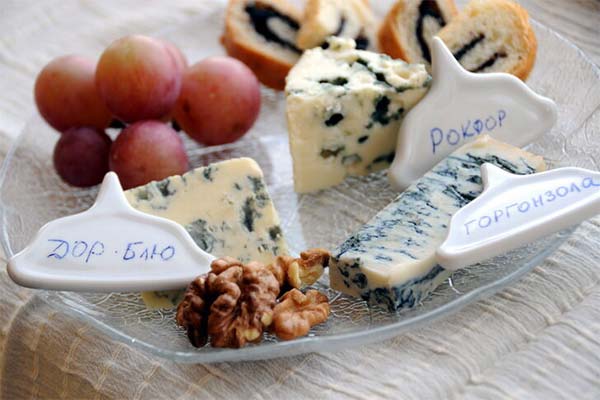
From dor bleu.
Cheeses are different:
The history of origin.
Equally popular is a type of German blue cheese with a mold called Dor Blue. Fans give high marks to this type of product. Some are willing to overpay to enjoy a piece of such a cheese delicacy. But the recipe for its preparation is still kept secret.
The taste, flavor, texture
Dor-blue cheese has the color of white marble with veins of dark green mold. It matures in ninety days. The taste is slightly spicy with a spicy aftertaste of straw. It has a characteristic aroma, thick cream, more like butter. It differs in the density of its structure from gorgonzola.
From Roquefort.
Cheeses are distinguished from:
History of origin.
Roquefort is one of France's tastiest blue cheeses. There is a legend about its emergence that is a little different from the origin story of gorgonzola. It all started in the French town of Roquefort, with its gorgeous mountain reliefs and many caves. In one of them was a shepherd who decided to eat a piece of bread and cheese. But his attention was distracted by a beautiful girl who passed by. Dropping his lunch, the boy followed her. He returned after one month. And on the food he left behind (bread and cheese) he saw a blue mold sprouting. But the shepherd was too hungry to think about the missing food. When he began to eat the cheese, the smell of the spice and the salty taste enthralled him. And so came the product, which the inhabitants called "Roquefort". It is made from sheep's milk in only one place, the province of Ruehrg.
The taste, flavor, texture
Roquefort cheese is covered in a white, moist crust when finished. It has a creamy, grayish interior flesh, with holes of sprouted blue mold. It matures in limestone grottos. Therefore it is impossible to cut the cheese mass with a simple knife, only with an individual device, which was invented especially for this kind of cheese. The name of this device is rokphorizeka.
Composition and calories
The composition of gorgonzola includes whole cow's milk and mold fungus spores. By calories this type of cheese is 350 kcal per 100 grams (18 grams of animal protein and 27 grams of digestible fat). Until the twentieth century gorgonzola cheese remained known only to the local public. Much later, as the industry developed, the product became popular with the English, Germans and the French. Where individual types of gorgonzola appeared: dolce and picante.
It contains:
- vitamin A;
- vitamin PP;
- B vitamins;
- calcium;
- phosphorus;
- potassium;
- antioxidants.
How gorgonzola cheese is useful
A properly made cheese tastes great. It contains nutrients that are good for the human body. Gorgonzola cheese contains proteins, fats and vitamins. And the mold located in it plays a role of antioxidant. In the process of cheese-making milk proteins are broken down into free amino acids, which are perfectly acceptable for the body and contribute to the synthesis of their own proteins.

The peptides included in the cheese stimulate the immune system, normalize blood pressure, control the nutritional processes in the gastrointestinal tract. Calcium, which is contained in the product, is well absorbed by the body. For the elderly, the product is useful because it prevents the development of osteoporosis.
The benefits that a person receives with reasonable consumption of this product is great. The useful substances in the composition:
- reduce the level of cholesterol in the blood;
- strengthen and develop bones, give health to nails, hair and teeth;
- have a positive effect on the nervous system;
- improve memory and concentration;
- help with sleep disorders;
- protect the skin from ultraviolet rays;
- Help with anemia and anemia;
- relieve fatigue.
Gorgonzola can be added to the diet of people who are lactose intolerant. The presence of fatty acids in the cheese, helps to eliminate toxins and impurities from the body, increases the appetite.
The most important component in the cheese product is penicillin. It keeps the whole human body healthy and effectively fights viral and infectious diseases.
Scientists have proven that people who make cheese are healthy, hardy and live a long life.
Harms and contraindications
In addition to its nutritional value and benefits, gorgonzola cheese also has contraindications. Due to the high fat content and high number of calories, this product will not benefit such people:
- Those who are overweight;
- Allergic to penicillin;
- Those who follow diets with a minimum amount of fat;
- People with diseases of the gastrointestinal tract (ulcers, gastritis).
It is not recommended to eat gorgonzola for children under 5 years old, pregnant women, breastfeeding women. It is forbidden to eat this cheese while taking antibiotics. Mildew mushrooms have similar properties to these medicines, which can cause dysbacteriosis, allergies in a person.
How to choose and store correctly
In order not to make a wrong choice, you should pay attention to its characteristics: type, flavor, date of production and shelf life. Gorgonzola is an Italian type of cheese. It is very similar to such varieties as dor-blue and dana-blue. But they differ from each other by the color of the mold. To mature young cheese is enough from two to four months, the most formed cheese with a maturity period of about a year.
In terms of appearance, you should choose a product white or slightly yellowish color. In the cracks of the cheese should be greenish-blue mold. Gorgonzola is a very mild variety and has a pronounced spicy taste with a nutty flavor. Mature cheese has the most pungent flavor.
When choosing a gorgonzola, true lovers of it stop at the more mature variety. The longer it matures, the spicier the flavor. This cheese creation does not have an indefinite maturation period, so buy the amount that is immediately consumed within a few days. The product is stored in the refrigerator for no more than 2 weeks.
Before you start eating gorgonzola cheese, it is recommended to take it out of the fridge half an hour before eating. Then it acquires the right consistency and reveals its flavors.
How and with what to eat gorgonzola
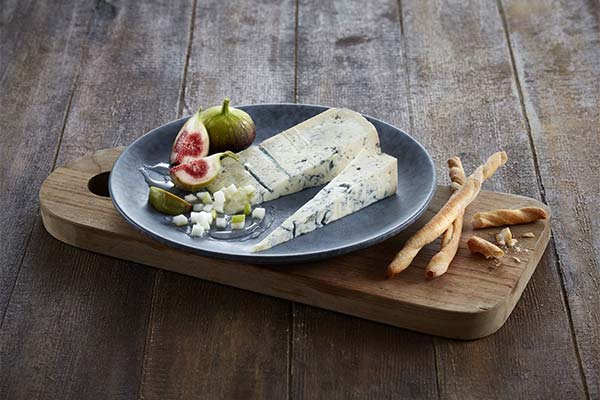
This type of cheese is suitable for cooking a variety of dishes, both simple and complex. Its softness gives a wonderful flavor and conveys shades of flavor. Due to its pasty texture, it is often used for sandwiches. Sweet and spicy gorgonzola is used in the recipes of various dishes. In terms of sweetness, the cheese is more convenient to cook because of the consistency of the cream, it easily melts in the mouth. Excellent with dried fruits, bitter foods (radicchio cabbage, arugula) and sweet foods - pumpkin, pear, apples, grapes. Complement its flavors when baking desserts. It is added to cheesecake as a filling.
Harmonizes with Italian polenta dish, various mushrooms and fondue. It is obligatory to add fried croutons to these recipes. Gorgonzola is used in cooking as a separate dish, combines with different kinds of hard and soft cheeses. Italians try blue cheese with freshly baked bread and crackers. Remarkably enriches the taste of meat roasted on coals. When served, it looks beautiful on the plate.
What wine goes well with gorgonzola?
In restaurant food renditions, it is common to order gorgonzola and wine. The two products complement each other perfectly. But because there are many varieties of cheese and a wide variety of wines, combining them is not very easy. When combining wine and cheese, choose varieties that complement the flavor of the wine but do not overpower it.
Gorgonzola prevails multifaceted and voluminous flavor. It is recommended to serve this cheese with different wines. It can be dessert (Semillon, Riesling, Sauvignon Blanc), fortified, rich dry white wines.
In contrast to red wine, white wine is able to be combined with several kinds of blue cheese. This wine tends to bring out the spicy flavor of the firm, salty varieties. Softer varieties are served with red wine.
Ideal pairing is gorgonzola with Marsala, Picolit or Passito wines. These noble grape varieties are made from the highest grapes. They are in perfect harmony with the flavors of Italian cheese.
Where to buy and how much it costs
Gorgonzola is produced in large quantities. Because of its limited shelf life, this product is packaged in small, packaged portions for sale.
In Italy, the price of blue cheese is about 6-9 euros (250 g) and 25-36 euros (1 kg). In domestic stores gorgonzola can not be officially purchased, however, through the Internet residents of Russia can buy the product at a price of 300-500 rubles per 200 g.
How to cook gorgonzola at home
Making this cheese at home is much better and less dangerous than buying it on various sites. Given that this is a product that includes milk, delivery should be as fast as possible, which is not always taken into account by representatives of various online food stores.

It is not difficult for housewives to prepare the cheese product at home. For gorgonzola, the following ingredients are taken:
- 7.5 liters of milk (it must necessarily be pasteurized);
- 70g of white yogurt without any fruit flavorings;
- 0.5 g teaspoon of mesophilic sourdough;
- 0.5 teaspoon of special bacteria for blue cheese Penicillium Rogueforti;
- half a tablespoon of liquid rennet;
- salt to taste;
- half a teaspoon of calcium chloride.
Preparation:
- Pour two liters of milk into a saucepan, add the bacteria, let stand for half an hour. During this time the acclimatization of bacteria. Then add the rest of the milk. Put the saucepan in a large saucepan with hot water and heat the milk in a water bath up to 32 ° C. Stir constantly and make sure that the temperature corresponds to that in the recipe.
- When it has reached the right temperature, add, sprinkling the mesophilic starter lightly on top of the milk. Wait for the powder to moisten for two minutes, then stir. Set aside for one hour. The temperature at this point should be 32°C. Then add the rennet and allow to stand for 30 minutes again, maintaining the same temperature.
- When the curd mass is formed, you need to make vertical and horizontal cuts two and a half centimeters wide on it. The cuts should be arranged in the form of a checkerboard. Taking a spoon, you need to carefully tear the long strips that have been obtained. Then slowly stir the cottage cheese for five minutes. Rest for 15 minutes, remembering to stir lightly every 5 minutes.
- When the mass has rested, you need to remove about 1.5-2 liters of the resulting whey and stir again for five minutes. And for the last time let it rest, stirring for the same amount of time. Thanks to these procedures, the cheese will retain its crumbliness, the outer part of the curd will strengthen and mold will be able to develop again.
- To drain the whey better, put on a colander with boiling water, smeared with butter. The whey is strained, stirring gently. For the blue mold to develop well in the cheese mass, in no case you can not squeeze it, so that the internal cavities are preserved.
- Sanitize the cheese mold along with two drainage (or bamboo) mats. Place the mat on a rigid plate made from a square plywood sheet. Move the cottage cheese into the mold, compacting around the edges to firm the surface of the cheese. But the mass inside should crumble and feel free.
- When the cottage cheese is ready, for 5 hours, you need to keep it in a warm place, maintaining a temperature of 32 ° C. Turn the cheese several times during the hour and then once for the rest of the time. This process will allow the cheese to firm up.
- To salt the resulting product you should use cheese salt, about 2-2.5% of the mass. Dry salting uses 0.96 grams of salt. It is applied evenly on top of the cheese, then rubbed into the sides with your hands. After a while, the salt will dissolve and be absorbed into the cheese. In the morning, turn the cheese over and again apply salt in the same method. And so continue to do for two more days.
- During this time the cheese is prepared for maturation. You need to leave it for 7-10 days to age, providing a temperature of 11-12 ° C and humidity of 95%. If the rind is very dry, increase the humidity, and if on the contrary, reduce it. Take long spears, disinfecting them well in advance, and pierce the cheese with them, making holes of 2-2.5 cm each. Leave the cheese to mature for good. After 90 days you can serve the cheese.
Recipes for dishes with Gorgonzola cheese
Pizza with pears
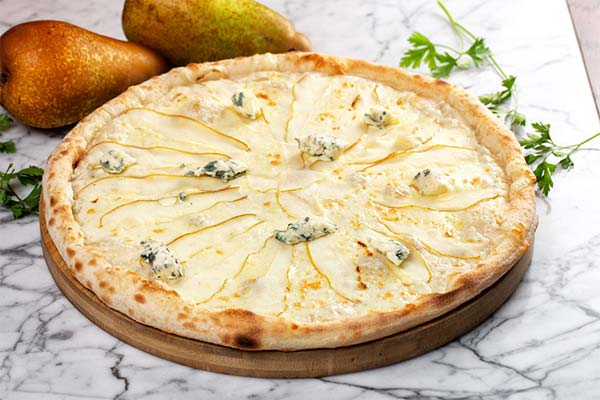
To make a pizza with pears, you will need:
- 250 g conference pears;
- 250 g g gorgonzola cheese;
- 200g of mozzarella cheese;
- 0,15 l of olive oil;
- 300 g wheat flour;
- 50 g arugula;
- 200 ml water;
- 2 tbsp. spices;
- 1 tbsp dry yeast.
Add the yeast and salt to the sifted flour. While stirring slowly pour water, make sure that no lumps form. Add olive oil to make the dough elastic. Bring the dough to a homogeneous mass, wrap in clingfilm and leave in the refrigerator for 30 minutes. Break the mozzarella cheese into medium slices, the gorgonzola into larger pieces and the pear into thin slices. Take the dough out of the cold and roll out a thin layer on parchment paper and place it on a baking tray, put the mozzarella on top, then the pear, sprinkle the top layer with cheese. Place in a baking tray heated to 180°C and bake for 20 minutes. Ready, browned pizza, take out of the oven, garnish with sprigs of arugula and moisten lightly with butter.
Mussels
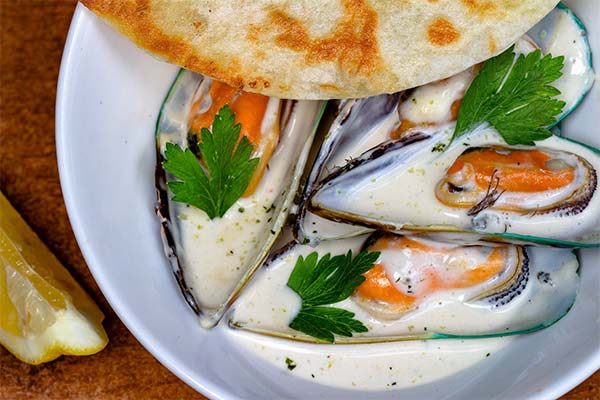
The recipe for the mussels includes:
- half a pound of mussels;
- 0.15 l of cream (33%);
- 10 g garlic;
- 50 ml of olive oil;
- 20 g of onions;
- 0.1 g thyme
- 50 g gorgonzola cheese.
Heat a pan on the stove, pour in the mussels, cover and wait 3 minutes. This is enough time for the seafood to crack. In a heated frying pan with vegetable oil, fry half of the onion, whole garlic cloves and thyme. Add the cream and cheese, salt and leave to simmer on a low heat for 5 minutes. You should get a smooth consistency. Then pour the mussels into the sauce, bring to the boil, and turn off. Dish is ready!
Pasta and cheese
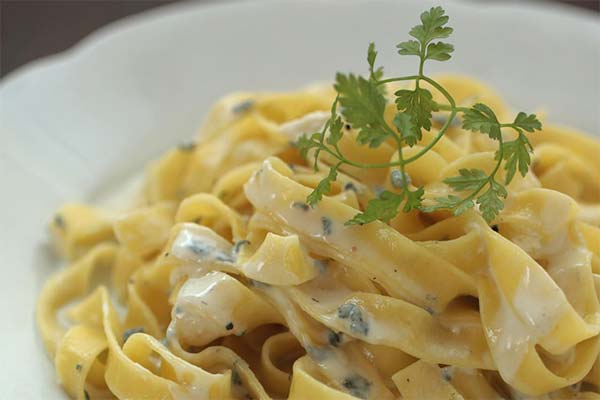
Pour water into a pan (1 liter per 100g of pasta) and bring to boil. Taste and season with salt, then add the pasta and stir. Cook for 7-8 minutes. Make sure the pasta is not too cooked, it should be al dente (cooked but not too hard). While the noodles are cooking, heat olive oil in a frying pan, add one clove of garlic and saute for five minutes. Then, make sure to remove the garlic from the oil, add cream (100g), melt Gorgonzola cheese (100g), add grated Parmesan cheese (50g). Simmer for 2 minutes, then remove from the heat. Pour the cooked, boiled pasta into the sauce, cover and let stand for a few minutes. Then sprinkle more grated parmesan cheese (30 g) and serve.
Cheese Soup
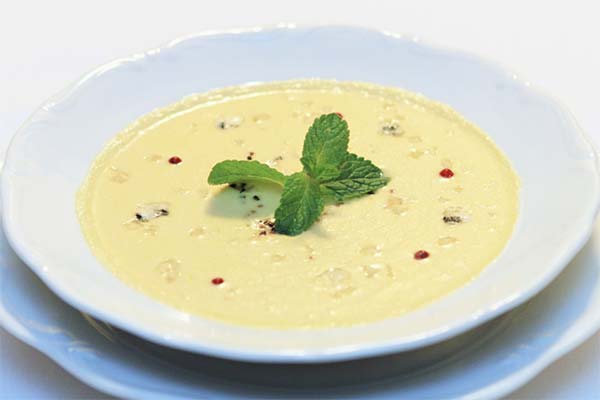
For cheese soup you will need:
- 500 ml of water;
- 100g of fresh mushrooms (champignons);
- 100 g g gorgonzola cheese;
- 100 ml of cream 20% fat;
- one pear;
- 2 tablespoons of wheat flour.
Clean the mushrooms, wash and cut into small slices. Add butter to a saucepan and heat over medium heat, put the mushrooms and fry for five minutes until golden. Then sprinkle them with flour and fry for a couple of minutes.
While stirring mushrooms, add water, salt and pepper it a bit, bring to the boil and add grated cheese. Bring it to the boil, boil it for 5 minutes and then take it off heat. Serve on a plate and garnish with the soup and pear slices.
Ice Cream
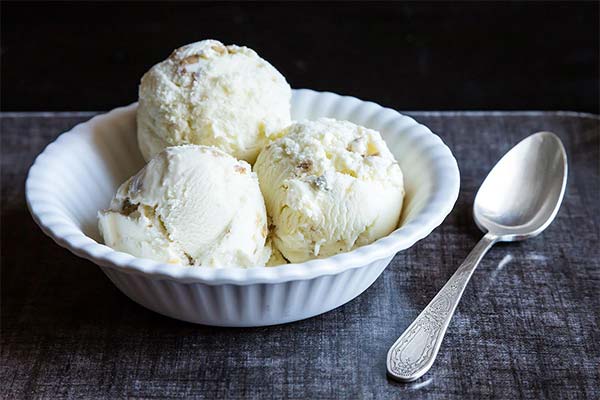
In Southern Italy, a very popular dessert is ice cream with gorgonzola cheese. It perfectly combines the savory flavors of creamy ice cream with a touch of cheese.
For this dessert you will need:
- 100 g g gorgonzola cheese;
- 100 g of mascarpone cheese;
- 250 ml of milk;
- 250 ml of cream with a fat content of 30%;
- 3 egg yolks;
- 30 ml of flower honey;
- 30 grams of walnuts.
To start, you need to mix, using a blender, milk, yolks and cream. Whisk the mass for 10 minutes, then put it in cold water with ice to cool it. Separately mix the varieties of cheese, put in a water bath and melt. Then add the honey, mix well and pour into the cooled mass. Put everything into special molds for ice cream and put in the freezer for five hours. Before serving, sprinkle the ready ice cream with the crumbled nuts.
What can be substituted for gorgonzola cheese in the recipe
Sometimes you come across recipes with blue cheese, and you can't find it. We have to not toss the recipe aside. Cheese can be replaced by other varieties with similar qualities and texture. This can be expensive varieties: Viola, Dorblue, or the well-known, inexpensive processed products called "Druzhba", "President". Dishes with such cheeses differ only slightly, but give no less pleasant taste and harmonize no worse with other products.
Interesting facts about cheese
Blue cheeses are the most famous. Elegant drawing, delicate structure has always distinguished this product from other varieties. But there are facts that tell the story:
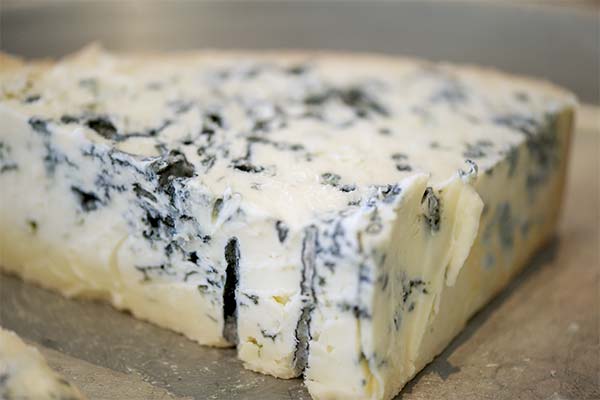
- One of the oldest blue cheeses in the world is the variety gorgonzola. Its name was first heard in the nineteenth century. To this day, the texture and recipe of this product has been carefully preserved. Gorgonzola cheese is not only revered in its age, but also for its manufacturing techniques.
- The greenish-blue color pattern of the mold itself is influenced by the mold component Penicillium. This creates an ornamental pattern, a delicate structure and a distinctive aroma.
- The Penicillium mold itself first appeared in a stale loaf of bread. It was later introduced into the cheese industry, transferred to the curd mass and observed its movement inside during maturation.
- Gorgonzola cheese is considered one of the healthier varieties. It contains various vitamins, carbohydrates, proteins and fats.
- The famous story "Three in the Boat, Not Counting the Dog," by Jerome K., mentions gorgonzola cheese. The writer describes the flavorful qualities of the product, comparing it to the killing power that can knock down even a horse.
- Cheese lovers are called tourophiles. From the Greek it translates as the word "cheese." Gorgonzola is in the kitchens of most countries today. But the home of this variety remains Italy and France.
«Important: All information on this site is provided for informational purposes only purposes. Consult with your health care professional before applying any recommendations. specialist before using the recommendations. Neither the editors nor the authors shall be liable for any possible harm caused by materials."

